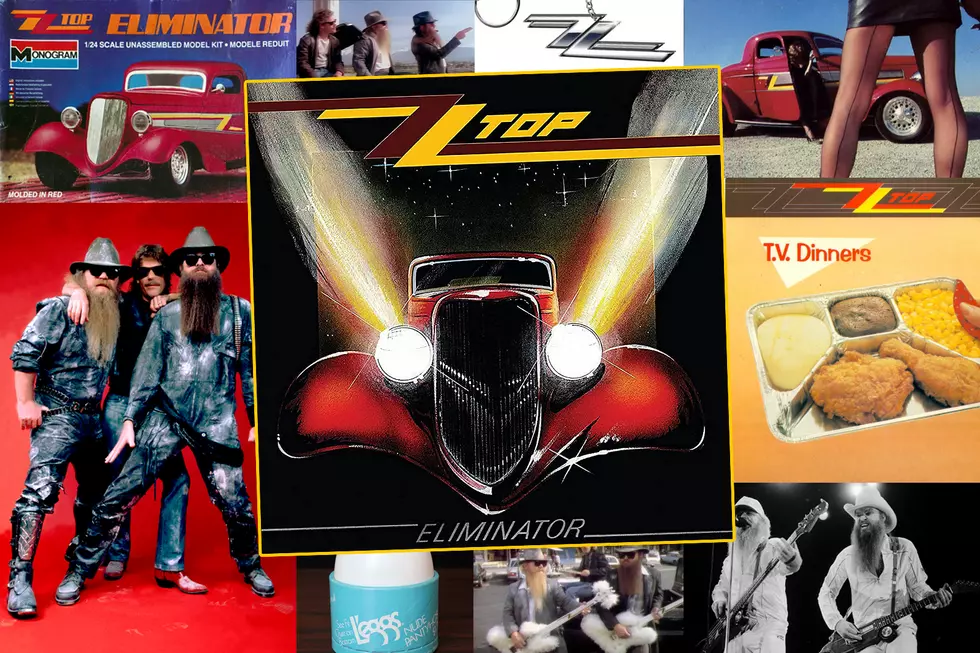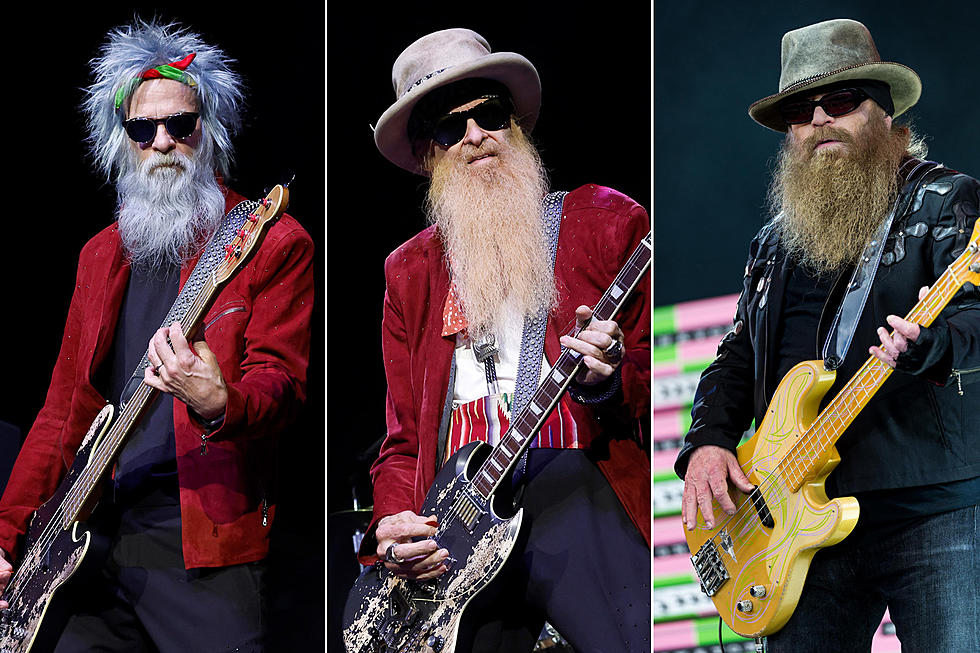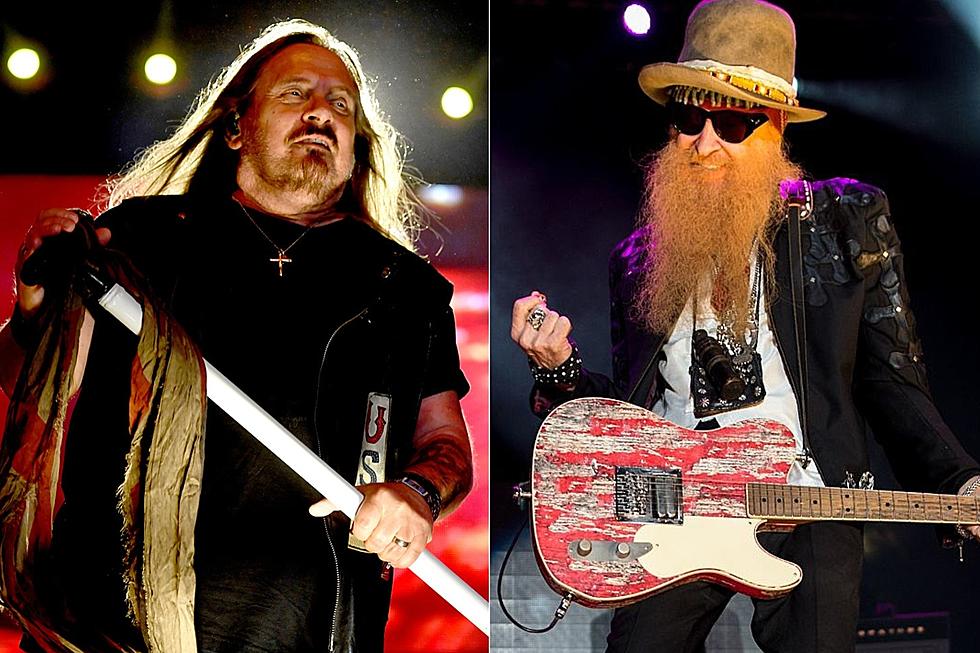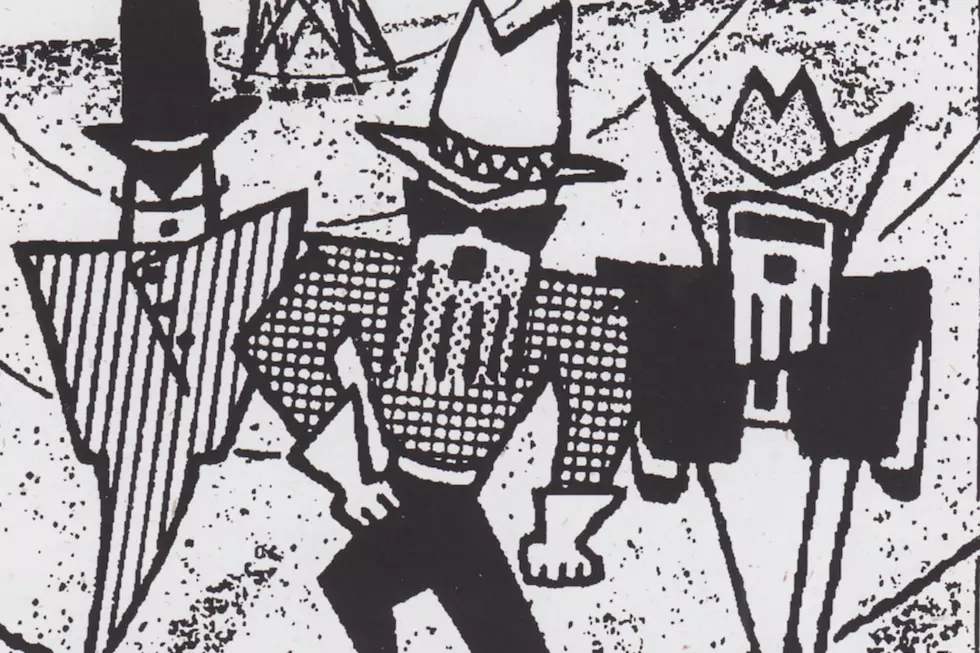
ZZ Top’s ‘Eliminator': 40 Sharp-Dressed Facts You May Not Know
Eliminator arrived on March 23, 1983, forever changing ZZ Top's career trajectory.
They became one of the biggest acts on the planet with a new sound that was catchy and commercially friendly, yet held to the band's riff-driven blues roots. ZZ Top's invasion of pop culture came on all fronts: There were radio hits, a massive tour and, perhaps most importantly, eye-catching videos airing around the clock on MTV.
It's all here, as UCR presents 40 facts about this landmark release.
1. The Rolling Stones Helped Inspire New Direction
ZZ Top was touring Europe in 1982 when Billy Gibbons visited a local nightclub. Something sparked as he watched the crowd dance to the Rolling Stones’ 1980 single "Emotional Rescue." "[Billy is] extremely philosophical, a deep thinker and musically very aware," long-time engineer Terry Manning explained years later. "He started to analyze why ZZ didn't get played in dance clubs and concluded that they were not up to the required rhythmic capabilities. He asked me what we could do. I started going to clubs and studying beats."
2. Depeche Mode and Ministry Also Played a Role
Music's evolution wasn't lost on Gibbons, who noticed the way synthesizers and electronic instruments were influencing popular songs. “All sorts of crazy sound-making machines were coming online,” Gibbons told the Houston Chronicle. “We began following the work that both Depeche Mode and Ministry were creating, which started our own ‘lab project’ in the studio and began combining guitar-based blues rock with a modern-day feel.”
3. There’s Some Punk in There as Well
Sure, the synths on Eliminator got all the attention, but another influence in its sound was punk rock. “We had been fortunately around the planet, and one of the interesting side trips were the excursions we had through London. At that moment, that punk scene at a zenith,” Gibbons told the Houston Press. One act, in particular, struck a chord. “The Clash, they were a little more along the lines of what we were pursuing. ... They were fierce, no question about it. They had a punk synergism. Their music, I think, was a little more rock-oriented.”
4. Mayhem in Memphis
Demos for the album were hashed out at Frank Beard’s Houston home, then much of the LP was recorded in Memphis at Ardent Studios. The town’s vibe affected the album. “There’s a thread of music sounds that have always been part of the Memphis scene, and that was a big inspiration that kept us on track,” Gibbons later told Classic Rock. “But Memphis is also a great trouble-in-waiting town, and of course, we made the most of that, too. We would go gambling and carousing about at a dog track across the Mississippi River in West Memphis, Ark. Or else there were a couple of all-night, after-hours joints that were highly illegal, but where the dice games and good music would start to unfold.”
5. Studio History
Of course, ZZ Top wasn’t the first major rock act to record at Ardent. Led Zeppelin, Joe Cocker, Leon Russell, James Taylor and Big Star were just some of the many other notable acts to record there.
6. They Stayed at a Hotel Known for Celebrities … and Ducks
ZZ Top made the Peabody Hotel their home while in Memphis. Many celebrities were known to hang out at the historic location. Frank Beard said he found Jerry Lee Lewis playing the lobby piano one night during ZZ Top’s stay. Still, the hotel’s most famous residents are ducks who parade every day through the lobby and into the water of its decorative fountain.
7. A Different Duck Story
“Sharp Dressed Man” returned to pop-culture prominence in 2012 as the theme song to the hit reality TV series Duck Dynasty. The show ran for 11 seasons before ending in 2017. During the finale episode, ZZ Top performed “Sharp Dressed Man” alongside Duck Dynasty cast member Si Robertson.
8. That’s Billy Gibbons’ Car on the Cover
Gibbons commissioned a California hot rod shop to build a car in 1976 that he’d later dub “The Eliminator.” Based on a 1933 Ford Coupe, the vehicle boasted a Corvette engine. It was street-ready by 1983 and became famous thanks to the Eliminator album cover, as well as its use in ZZ Top’s most famous music videos. The hot rod is now housed at the Rock & Roll Hall of Fame, but Gibbons has visitation rights and takes it out for a spin whenever he passes through Cleveland.
9. The Car Served Another Purpose
Custom-made hot rods don’t come cheap: Gibbons' reportedly cost around $50,000 in 1983 – or roughly $151,000 today. He was able to write the cost off by using his Eliminator car for the album’s cover and music video since it qualified as a “work-related purchase.”
10. A Comic Book Designed the Cover
Tom Hunnicutt crafted the album’s cover art using Gibbons’ Eliminator car as a model. He had a long history of working for car and racing magazines, as well as classic car-centric comic books.
11. Their Drummer Was Initially Enamored With MTV
"Frank Beard was in bed watching TV and saw a music video and was stoked about it," publicist Bob Merlis told the Houston Chronicle. "Then another came on so, he didn't channel surf as was his habit. This went on for hours and hours when it dawned on him that he was watching MTV and they played videos around the clock."
12. Those Famous Videos Shared a Single Director
Warner Bros. record executive Jeff Ayeroff recognized MTV's influence on the changing music market. He recruited Tim Newman to helm the video for ZZ Top's "Gimme All Your Lovin,'" even though Newman was a largely unproven director who'd mainly worked in commercials. Things went so well that Newman was brought back for "Sharp Dressed Man" and "Legs," as well. “I’m not a person who talks a lot about himself but with those videos, I helped take ZZ Top from a successful regional touring band to an international superstar band,” Newman told the Boston Globe in 2020.
13. ZZ Top Director's First Video Featured a Different Hall of Famer
As the old saying goes, it's not what you know, it's who you know. In Tim Newman's case, it was cousin Randy Newman. Tim directed Randy's video for the buoyant tribute to Los Angeles, "I Love L.A." This work helped endear him to the ZZ Top team, and the rest is history.
14. The Band Helped Cast the ZZ Top Girls
“Tim was a great director,” Gibbons told Classic Rock. “By which I mean to say he told us we weren’t much to look at and so we’d need some pretty girls in the mix to sweeten up the story. He brought along a picture book of models to our first meeting. I said to him: ‘Well, slow down here and let’s take this page by page.’”
15. A Random Bar Patron Inspired 'TV Dinners'
Gibbons had a sweltering blues backing track for "TV Dinners," but was struggling to find lyrics that fit the groove. While in an East Memphis bar one night, “a young lady walked in wearing a painter’s white jumpsuit. As she strolled past I saw that she had the words ‘TV Dinners’ emblazoned on the back of the suit," he told Classic Rock. "I don’t know to this day why that was such a stimulus, but there the title of the song was. I went right on back to the Peabody, holed up in my room and scribbled out the words that night. Who’d have thought a rock ’n’ roll song would be about food?”
16. She Did Know How to Use Them
The famous lyrics to “Legs” inspired a female motorist who was (briefly) stranded on the side of the road. "I was driving in Los Angeles, and there was this unusual downpour. And there was a real pretty girl on the side of the road," Gibbons told Spin in 1985. "I passed her, and then I thought, 'Well, I'd better pull over' or at least turn around and offer her a ride, and by the time I got back she was gone. Her legs were the first thing I noticed. Then I noticed that she had a Brooke Shields hairdo that was in danger of falling. She was not going to get wet. She had legs and she knew how to use them."
17. 'Sharp Dressed Man' Is in the Eye of the Beholder
The concept of a "Sharp Dressed Man" naturally brings to mind images of expensive suits and designer shoes, but that wasn't necessarily what the band was going for. "Sharp-dressed depends on who you are," Dusty Hill told Spin. "If you're on a motorcycle, really sharp leather is great. If you're a punk rocker, you can get sharp that way. You can be sharp or not sharp in any mode. It's all in your head. If you feel sharp, you be sharp."
18. ZZ Top Took a Saw to Their Guitars
“The guy who does our guitars to this day, Mr. John Bolin, told us we’d need something different for television," Gibbons told Classic Rock. "John had a lumberjack’s saw, so Dusty and I took our perfectly good instruments over to him and he cut the tops off them. Somehow, all of those elements seemed to end up making perfect sense.”
19. The Hits Weren’t as Big as You Remember ...
With more than 10 million copies sold, Eliminator was an unmitigated commercial success. Yet it didn’t have the kind of chart-topping numbers you might expect. The album never climbed higher than No. 9 on the Billboard 200 chart, and none of the singles made the Hot 100 Top 5. “Gimme All Your Lovin’” made it to No. 37, “Sharp Dressed Man” stalled out at No. 56 and “Legs” fared best, peaking at No. 8.
20. ... But the Videos Were
The videos for "Sharp Dressed Man," "Gimme All Your Lovin'" and "Legs" proved groundbreaking. The mix of fast cars and beautiful women may not have been revolutionary from an artistic standpoint, but it was exactly what MTV needed. ZZ Top became unexpected superstars with a new generation of fans, while the fledgling network suddenly had proof of how powerfully they could influence an artist's career. ZZ Top delivered some of the era's most popular videos, and at the first annual MTV Video Music Awards in 1984, the band took home honors for Best Band and Best Group Video.
21. Those Spinning Guitars Were Custom-Made
The founder of Dean Guitars had been friends with Gibbons for years and previously supplied him with a red Dean ML. Then Dean Zelinsky was awakened in 1983 with a new request: “One night, I received a 3 a.m. phone call; it's Gibbons," Zelinsky said, noting that ZZ Top was on tour in the U.K. at the time. "At the end of the conversation, he drops the line, 'I’m sending you some sheepskins I purchased in Scotland, I want you to put them on some guitars.'" Zelinsky obliged and got the instruments done just in time for the "Legs" video shoot.
22. And They Were Dangerous
Sure, the spinning, fur-covered guitars looked cool in the "Legs" video – but they were also quite a hazard. “First time I tried it, of course, I knocked the shit out of myself upside the head,” Hill admitted to Classic Rock.
23. 'Legs' Ended Up Having … Legs
Beyond its initial chart success, "Legs" had lasting popularity. The track was regularly featured in films and TV shows, including such long-running series as Miami Vice, King of the Hill, American Dad and The Simpsons. The song was also licensed for L'eggs pantyhose commercials, and ZZ Top reportedly earned a multi-million dollar paycheck in the process.
24. ZZ Top’s Trademark Gesture Was Improvised
One of the many famous elements of the band’s Eliminator videos was a hand gesture. In it, the three band members start with two fingers pointing out, then wheel their arms in an exaggerated pointing motion. The signature move wasn’t planned. In the video for “Gimme All Your Lovin’,” ZZ Top had to do several takes while the car drove by. Boredom between takes led to the now-famous motion.
25. 'Eliminator' Featured More Than the Trio
Though the three members of ZZ Top were the only musicians to be officially credited, several others contributed to Eliminator. Linden Hudson played synthesizer and helped with the album’s production and arrangements. Terry Manning handled an array of electronic elements, including drum machines and keyboard bass. Jimi Jamison, who later fronted Survivor, delivered backing vocals.
26. Cranking it Up to 120
Following Linden Hudson's advice, the band determined that the optimum dance-rock tempo was 120 beats per minute. Though there were occasional variations – “Sharped Dressed Man,” for instance, is 125 BPM – the band more or less stuck with this rhythm on their drum machines. “A sense of importance was placed on timing and tuning,” Gibbons told Classic Rock, “and we spent a lot of productive hours making the most of keeping that record on a good tempo.”
27. The Album Led to a Lawsuit
Hudson wasn’t thrilled that his contributions went uncredited. He’d been a friend of Beard’s and even helped build the drummer’s home studio in exchange for free rent. The engineer and producer helped with demos in the album’s early stages, then aided in bringing synthesizer elements into the band’s music. "Linden Hudson in a fair world should have had his name all over Eliminator and gotten the just compensation he deserved,” stage manager David Blayney wrote in his 1994 book Sharp Dressed Men. Hudson took legal action when his name didn’t appear on the Eliminator credits, claiming he was involved in both production and songwriting. The case was settled in 1986 as the band paid Hudson $600,000. He was also given songwriting credit on one of Eliminator’s 11 songs, “Thug.”
28. It Turned Off a Faction of the Band’s Fanbase
The album marked a sharp stylistic change, as ZZ Top moved away from their tried-and-true blues-rock roots. The decision was commercially successful, but it wasn't without problems. They won over many new fans with this more accessible sound, while some blues loyalists were outraged. Criticism came from those close to the band, as well. “It seems funny now, but the few who did get to hear 'Legs' when we were recording were kind of shocked," Hill told Classic Rock. "To put it bluntly, we got a little shit for abandoning our basic sound.”
29. Long and Winding Road Trip
ZZ Top’s Eliminator tour kicked off May 6, 1983, in Jackson, Miss. The trek lasted through 1984, with a total of 151 performances in 11 different countries. Following the final stop, on April 16, 1984, in Sweden, the group then took a much-deserved break from the road. ZZ Top did not return to touring until December 1985.
30. It Was Challenging to Recreate the Songs Live
With a broader expanse of sounds on Eliminator, ZZ Top had to find a way to deliver the material on stage. Manning would be tasked with playing some parts back through a tape recorder during the shows. “It was a tough process because the band didn’t really play natively in the way Eliminator had turned out," he told Classic Rock. "They would come up with a set list, and I would go through and get sounds and beats to fit the songs taken from the actual four-track master tapes. I edited them as required, for instance, if they wanted to extend a particular song live. On the tour, I actually cued the band live with those things. One of my eight tracks was a stage cue where I would have a mic and yell out: ‘Bridge!’ which the band would hear in the stage monitors only. There were also lighting and stage automation cues. It was quite a thing to pull off – and I’m not sure that it always worked.”
31. The Hod Rod Came on Tour … Kind Of
ZZ top didn't bring the actual 1933 Ford hot rod on tour with them, but they found a way to make sure the distinctive car was integrated into their live show. The stage design during their Eliminator tour included a gigantic replica of the dashboard of the classic red roadster.
32. Some 'Eliminator' Tracks Have Never Been Performed
According to Setlist.fm, “Sharp Dressed Man,” “Gimme All Your Lovin’” and “Legs” respectively rank as the band’s fifth, sixth and seventh most-played songs in concert. The site also notes that three Eliminator tracks have gone unperformed by ZZ Top: “Thug,” “Dirty Dog” and “If I Could Flag Her Down.”
33. The Synths Were New, but So Were the Guitar Sounds
There was more to ZZ Top's sound on Eliminator than newly added electronics. “There was a lot of attention aimed toward developing a fierce guitar tone, where before some of the guitar sounds were a little cleaner,” Gibbons later told Goldmine. “This record, top to bottom, is absolutely fierce in the guitar department. Those guitar sounds were raging. ... Not only was the guitar taking on this ferocious character, Dusty fell in line and cranked up the wattage on the bottom end, as well. By and large, the collective work was really a great moment of exchange between the three of us.”
34. Keychain Gang
Like the Eliminator hot rod, the distinctive ZZ Top keychain was prominently featured in the music videos for “Sharp Dressed Man,” “Gimme All Your Lovin’” and “Legs.” The keychain became a popular collectible among fans and was still available for purchase on the ZZ Top web store decades later.
35. A Mini-'Eliminator'
ZZ Top’s iconic Eliminator hot rod became so popular that an official model car kit of the vehicle was released. At 1/24 scale, the replica wasn’t big enough for owners to drive on the streets, but it at least looked good on display in the home or office. Unfortunately, the model car didn’t come with action figure-sized versions of the band.
36. 'Eliminator' Reissue
An expanded edition of Eliminator was released in 2008. In addition to the original album tracks, it included a dance mix of “Legs,” plus live renditions of "Gimme All Your Lovin,’” “Sharp Dressed Man,” "I Got the Six,” "TV Dinners” and "Got Me Under Pressure.”
37. Gimme All Your Dance Moves
Martay scored a minor hit in 1999 with "Gimme All Your Lovin' 2000," a dance club-ready tune that sampled the ZZ Top classic. The English pop singer reached No. 28 in the U.K. and also charted in several other European countries. Martay’s future singles didn’t continue that success, but she carved out an impressive career writing songs for other artists and performing in the theater – including the London run of The Lion King.
38. Notable Covers
Songs from Eliminator have been covered by a wide range of artists over the years, including Kid Rock, Ministry and "Weird Al" Yankovic. The most star-studded tribute arrived as part of 2011's ZZ Top: A Tribute from Friends. The LP found Fleetwood Mac members Mick Fleetwood, John McVie, and touring keyboardist Brett Tuggle teamed with blues singer Jonny Lang and Aerosmith’s Steven Tyler on a rendition of “Sharp Dressed Man.”
39. The Album Never Hit No. 1
Eliminator never really came close to hitting No. 1 on the Billboard chart, despite its huge hit songs, massively popular videos and sales of more than 10 million copies. Michael Jackson's Thriller and the Police's Synchronicity combined to hold the top spot for 39 of 1983's 52 weeks. Eliminator could never get higher than No. 9, though it did stay in the Billboard 200 for an impressive 185 weeks.
40. LP's Influence Was Felt on ZZ Top's Follow-Up
The success of Eliminator kept ZZ Top going down their newly forged, synth-lined path. The band’s follow-up, 1985’s Afterburner, featured even more electronic effects. The LP did well, going multi-platinum and reaching No. 4 on the Billboard 200, but critical response was generally mixed. Only “Sleeping Bag” was able to match the success of their Eliminator singles.
Top 25 Southern Rock Albums
You Think You Know ZZ Top?
More From Ultimate Classic Rock









